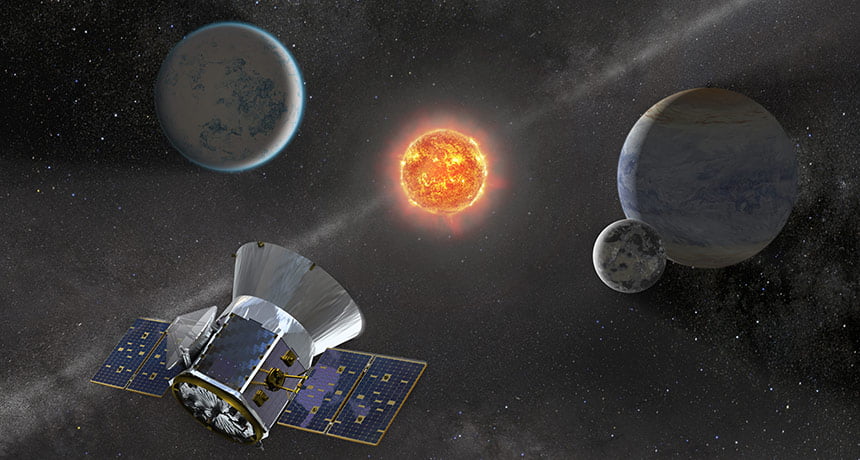
NASA is stepping up its search for planets outside our solar system. Its next exoplanet hunting telescope, the Transiting Exoplanet Survey Satellite (TESS), is due to launch from Cape Canaveral on the evening of April 16.
Following the Kepler space telescope’s discovery of more than 5,000 possible exoplanets since 2009, TESS will continue the galactic census — flagging more planetary candidates for further study.
Astronomers expect TESS to find about 20,000 planets in its first two years in operation, focusing on nearby, bright stars that will be easy for other telescopes to investigate later. About 500 of those expected exoplanets would be less than twice the size of Earth — and therefore may be good places to look for life.

SMALL BUT MIGHTY NASA’s next exoplanet hunting telescope, TESS, is only 1.5 meters tall (shown here with engineers). Its size is partly due to the fact that it was designed to launch on NASA’s small Taurus rocket, but will instead launch on a larger SpaceX Falcon 9 on April 16.
The TESS mission is “a whole new opening for exoplanet studies,” MIT astronomer Sara Seager, TESS’ deputy science director, said during a news conference describing the upcoming launch.
TESS will be the first NASA science mission launched on the SpaceX Falcon 9 rocket. Once in orbit, the spacecraft will trace an unusual, elliptical path between Earth and the moon that will enable it to observe at least 85 percent of the sky — 350 times as much sky as Kepler saw.
Most of the planets found by Kepler orbit stars 1,000 light-years away or farther. TESS will focus on 200,000 stars that are a few hundred light-years away at most, and shine between 30 to 100 times brighter on average than Kepler’s.
The brighter the star, the easier it is to determine its planet’s characteristics, such as its mass and whether it has an atmosphere, Seager says. “Photons are our currency — the more, the better,” she says.
That follow-up will help TESS avoid some of Kepler’s pitfalls. Because Kepler’s stars were so far and so dim, some of its planet candidates were confirmed as actual planets only by statistics rather than by other telescopes. And not all those confirmations may stick. A recent paper posted at arXiv.org showed that Kepler 452b, an Earth-sized planet that orbits a sunlike star at the same distance Earth orbits the sun, may be a mirage (SN: 8/22/15, p. 16). Many of TESS’ planets won’t face the same uncertainty.

COASTING IN SPACE The TESS satellite’s unusual 13.7-day orbit uses the moon’s gravity to stabilize it, so it needs little fuel. During the part of the orbit colored blue, TESS will observe the sky. During the part marked in orange, it will transmit data back to Earth. The gray ring marks the moon’s orbit.
But the way TESS will search for exoplanets is the same as Kepler: The satellite will watch stars for signs of dimming, which can indicate that a planet is transiting, or crossing in front of, the star. Measuring how much starlight is blocked can tell astronomers the size of the planet.
Once TESS finds a planet, astronomers will need more information to understand its qualities, such as whether it’s rocky or gassy (SN Online: 6/19/17). For that, other telescopes will follow up. Ground-based telescopes will measure the gravitational tug of a planet on its host star to learn the planet’s density, which is a clue to its composition. Astronomers plan to measure masses for at least 50 TESS planets that are smaller than Neptune in the hopes that many of them will have rocky, and therefore potentially habitable, surfaces.
Undiscovered country
Before TESS, most known planets were more than 1,000 light-years away, with a few closer than 30 light-years (a parsec is 3.26 light-years). TESS (orange circles) will fill in the gap. The size of the circles represents how easy the planets are to find.

NASA’s James Webb Space Telescope, now scheduled to launch in 2020, will then check some of those planets for signs of life (SN: 4/30/16, p. 32).
“This is one of the major questions that TESS is intended to answer: Where will we be pointing Webb?” said the mission’s principal investigator, MIT astronomer George Ricker, at the press conference. Webb will peer at the starlight filtering through planetary atmospheres to try to detect molecules that could be produced by something living on the surface.
It will take a few months for TESS to swing into its regular orbit before it begins collecting data. At that point, it will be able to use the moon’s gravity to stabilize itself for decades in orbit without using extra fuel. The mission is set to last two years, but could continue taking data almost indefinitely.
“TESS is not going to be limited by any expendable or other aspects,” Ricker said. “It will be basically limited by how long NASA has the patience to fund the mission.”
[“Source-sciencenews”]




